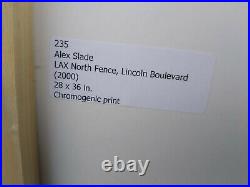
Daily Archives: March 31, 2024


Otis Institute Asst Chair Los Angeles Artist/Photo High Definition Alex Slade










Otis Institute Assistant Chair Los Angeles Artist/Photographer Alex Slade…. 28 x 36 Chromogenic Work by LA artist Alex Slade. Only flaw is a scrape on the plexiglass: not very noticeable. Please read Bio for more info. Great shot of the perfect of LAX. Known for elevating ordinary landscapes to art at its fullest. Born in Toledo, OH. Lives and works in Los Angeles. Alex Slade completed a Bachelor of Arts degree from University of Michigan, Ann Arbor, MI and a Master of Fine Arts degree from California Institute of the Arts, Valencia, CA. Slade’s photographs chronicle his own wanderings and define a narrative in U. Cities where corporate capitalism dominates the urban fabric. He has had solo exhibitions at the University of Southern California, Los Angeles, CA; Edward Cella Art + Architecture, Los Angeles, CA; Santa Monica Museum of Art, Santa Monica, CA; Mary Goldman Gallery, Los Angeles, CA; Els Hanappe Underground, Athens, Greece; Wienowski & Harbord, Berlin, Germany, and Kunstlerhaus Bethanien, Berlin, Germany. Group exhibitions include Haus der Kulturen der Welt, Berlin, Germany; Carpenter Center, Harvard University, Cambridge MA; Los Angeles Municipal Gallery, Los Angeles, CA; California Museum of Photography, Riverside, CA; Museum of Modern Art, New York, NY; Hammer Museum, Los Angeles, CA; Museum of Contemporary Art, Miami, FL; and Artists Space, New York, NY. Slade received a City of Los Angeles, Individual Artist Fellowship (2008), and a California Community Foundation Individual Artist Fellowship (2006). His work is included in the collection of the Los Angeles County Museum of Art, Los Angeles, CA. What is a Chromogenic Print? Chromogenic prints, often referred to as c-type’ prints are prints produced using chromogenic materials and processes. Chromogenic materials, such as film or photographic paper, are composed of one or many layers of silver halide emulsion. Along with dye couplers, and in combination with processing chemistry, these chemicals form visible dyes. Full color chromogenic materials are comprised of multiple layers of emulsion that are sensitized to different wavelengths of light and of which the three main dye layers – cyan, magenta and yellow – together form a full color image. The first commercially available chromogenic print process available was Kodacolour, which was introduced by Kodak in January 1942.
